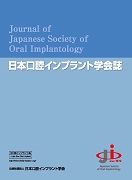Volume 36, Issue 3
Displaying 1-11 of 11 articles from this issue
- |<
- <
- 1
- >
- >|
Special Articles : What Are the Conditions for a Successful Maxillary Implant Overdenture?
-
Article type: Special Articles : What Are the Conditions for a Successful Maxillary Implant Overdenture?
2023Volume 36Issue 3 Pages 145
Published: September 30, 2023
Released on J-STAGE: October 20, 2023
Download PDF (899K) -
Article type: Special Articles : What Are the Conditions for a Successful Maxillary Implant Overdenture?
2023Volume 36Issue 3 Pages 146-150
Published: September 30, 2023
Released on J-STAGE: October 20, 2023
Download PDF (1423K) -
Article type: Special Articles : What Are the Conditions for a Successful Maxillary Implant Overdenture?
2023Volume 36Issue 3 Pages 151-159
Published: September 30, 2023
Released on J-STAGE: October 20, 2023
Download PDF (3281K) -
Article type: Special Articles : What Are the Conditions for a Successful Maxillary Implant Overdenture?
2023Volume 36Issue 3 Pages 160-169
Published: September 30, 2023
Released on J-STAGE: October 20, 2023
Download PDF (2987K)
Special Articles : Challenge of Today for MRI Examination
-
Article type: Special Articles : Challenge of Today for MRI Examination
2023Volume 36Issue 3 Pages 170
Published: September 30, 2023
Released on J-STAGE: October 20, 2023
Download PDF (898K) -
Article type: Special Articles : Challenge of Today for MRI Examination
2023Volume 36Issue 3 Pages 171-176
Published: September 30, 2023
Released on J-STAGE: October 20, 2023
Download PDF (1778K) -
Article type: Special Articles : Challenge of Today for MRI Examination
2023Volume 36Issue 3 Pages 177-184
Published: September 30, 2023
Released on J-STAGE: October 20, 2023
Download PDF (2334K) -
Article type: Special Articles : Challenge of Today for MRI Examination
2023Volume 36Issue 3 Pages 185-189
Published: September 30, 2023
Released on J-STAGE: October 20, 2023
Download PDF (2425K)
Original Paper
-
Article type: Original Paper
2023Volume 36Issue 3 Pages 190-197
Published: September 30, 2023
Released on J-STAGE: October 20, 2023
Download PDF (1586K)
Case Reports
-
Article type: Case Reports
2023Volume 36Issue 3 Pages 198-204
Published: September 30, 2023
Released on J-STAGE: October 20, 2023
Download PDF (3265K) -
Article type: Case Reports
2023Volume 36Issue 3 Pages 205-210
Published: September 30, 2023
Released on J-STAGE: October 20, 2023
Download PDF (2220K)
- |<
- <
- 1
- >
- >|
